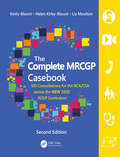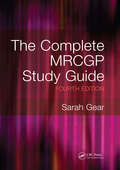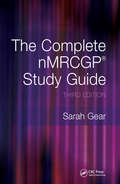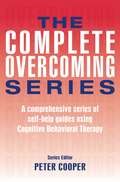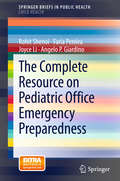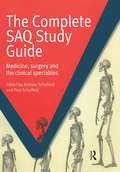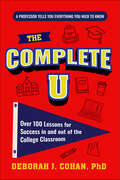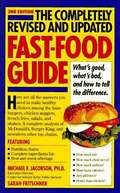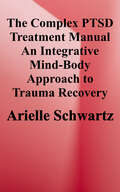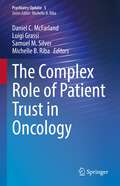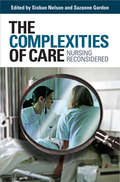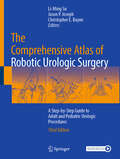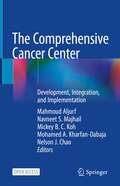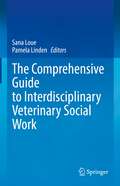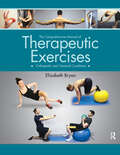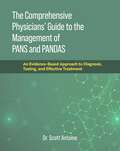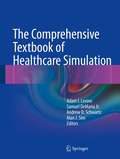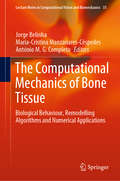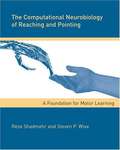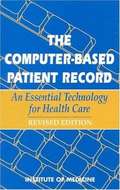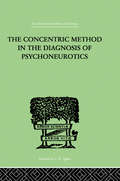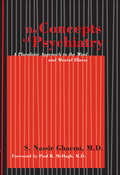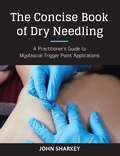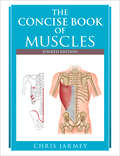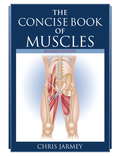- Table View
- List View
The Complete MRCGP Casebook: 100 Consultations for the RCA/CSA across the NEW 2020 RCGP Curriculum
by Liz Moulton Emily Blount Helen Kirby-BlountThis is the most comprehensive resource for trainees sitting the RCGP consultation skills’ exam (RCA/CSA), offering a complete curriculum guide as well as 100 roleplays that can be removed and practised in pairs. The guidance is seamlessly aligned to the NEW RCGP 2020 curriculum, fully up to date and referenced with the latest guidelines, with detailed ‘example’ answers for each case. Offering a new, straightforward consultation model highly suited to the requirements of the exam, the book provides: A realistic amount of information for both ‘doctor’ and ‘patient’. The answers! Each case includes a fully worked-up example consultation. Summaries of guidelines and tips from the authors own experience of the RCGP exams - both as candidates and as teachers for many hundreds of trainees. An easy way to mark each other’s role plays, with tick boxes on the Example Consultation and a universally applicable marking scheme. A colour coded curriculum for ease of reference. The only Casebook and revision guide providing information and answers across the 2020 curriculum. The Complete MRCGP casebook is essential reading for any candidate preparing for their final clinical and consultation skills’ exam and will remain an invaluable resource for best practice after qualification.
The Complete MRCGP Study Guide, 4th Edition
by Sarah GearThis new edition of the MRCGP Study Guide has been purposely revised and updated to comprehensively cover every aspect of the membership examination of the Royal College of General Practitioners. It takes you through all the main medical topics fundamental to general practice, all relevant non- clinical areas, and then finally tests you with an AKT and CSA style examination. All the information you need in one place. This guide can be used as a source of reference, and for revising, to ensure you are perfectly prepared. It saves you the colossal amount of time you would otherwise need to cover the same ground.
The Complete NMRCGP Study Guide
by Shoaib Siddiqui Sarah GearThis greatly expanded, revised and updated new edition of the Guide comprehensively covers every aspect of the new membership examination of the Royal College of General Practitioners, the nMRCGP[registered]. It takes you through all the main medical topics fundamental to general practice, all relevant non-clinical areas, and practice for the examination itself. Use this book as a starting point, a guide, or for summing up to ensure you are as well read as you think you are. The aim is to save you the colossal amount of time you would otherwise need to cover the same ground and have all the information you need in one place. 'General Practice is a fantastic career and the MRCGP has always been a worthwhile exam to work for. You will get an incredible amount out of it that will form a solid base for your career, if you are willing to put in the time and effort. Enjoy, and good luck!' - Sarah Gear.
The Complete Overcoming Series: A comprehensive series of self-help guides using Cognitive Behavioral Therapy
by Prof Peter CooperThe complete set of self-help guides from the popular Overcoming series. Each guide is based on Cognitive Behavioral Therapy (CBT), an evidence-based therapy which is recommended by the NHS for the treatment of a large number of psychological difficulties. Each guide comprises a step-by-step self-help programme based on CBT and contains:-Useful information about the disorder-Practical strategies and techniques based on CBT-Advice on how to keep recovery going-Further resourcesThe Complete Overcoming Series contains 31 titles:Overcoming Anger and IrritabilityOvercoming Anorexia NervosaOvercoming AnxietyOvercoming Body Image Problems including Body Dysmorphic DisorderOvercoming Bulimia Nervosa and Binge-EatingOvercoming Childhood TraumaOvercoming Chronic FatigueOvercoming Chronic PainOvercoming Compulsive GamblingOvercoming Depersonalization & Feelings of UnrealityOvercoming DepressionOvercoming GriefOvercoming Health AnxietyOvercoming Insomnia and Sleep ProblemsOvercoming Low Self-EsteemOvercoming Mood SwingsOvercoming Obsessive Compulsive DisorderOvercoming Panic and AgoraphobiaOvercoming Paranoid and Suspicious ThoughtsOvercoming PerfectionismOvercoming Problem DrinkingOvercoming Relationship ProblemsOvercoming Sexual ProblemsOvercoming Social Anxiety and ShynessOvercoming StressOvercoming Traumatic StressOvercoming Weight ProblemsOvercoming WorryOvercoming Your Child's Fears & WorriesOvercoming Your Child's Shyness and Social AnxietyOvercoming You Smoking Habit
The Complete Resource on Pediatric Office Emergency Preparedness
by Angelo P. Giardino Joyce Li Rohit Shenoi Faria PereiraThis book describes key knowledge concepts, skills and up-to-date algorithms pertaining to common emergencies that can take place in a pediatric office, including: seizures, anaphylaxis and shock, and diabetic ketoacidosis. The authors supported by peer review from top specialists in Pediatric Emergency Medicine at the Baylor College of Medicine offer the first comprehensive educational resource on pediatric office emergency preparedness devoted exclusively to the practicing primary care health care provider and his/her team. During emergencies, providers and their staff are called on to work efficiently as a "code-team" which is a source of considerable apprehension for many primary care pediatricians. This unique reference guide contains a wealth of information and resources in a compact and practical form. It presents the most important knowledge, skills, office resources and team interactions required by practitioners to successfully treat pediatric emergencies in the office.
The Complete SAQ Study Guide: Medicine, Surgery and the Clinical Specialties
by Schofield AndrewThis detailed guide is a must for medical students preparing for clinical attachment and final exams. Its wide-ranging approach is also ideal for those sitting GP entrance exams. Presenting short answer questions encompassing the entire current curriculum, this informative revision aid covers all bases.
The Complete U: Over 100 Lessons for Success in and out of the College Classroom
by Deborah J. CohanThe Only College Guide You'll Ever NeedFind Meaning, Growth, and Joy in Your College JourneyThe Complete U is a supportive, real-world guide to thriving in college—academically, socially, and emotionally. With warmth, humor, and deep insight, Dr. Deborah J. Cohan delivers over 100 empowering lessons to help students navigate every aspect of campus life.The Complete U is your empowering, honest, and compassionate guide to navigating every step of the college experience. With over 100 lessons from sociologist and beloved professor Dr. Deborah J. Cohan, this transformative book offers the wisdom, support, and practical strategies every student needs to succeed in and beyond the classroom. Whether you&’re a first-year student or preparing to graduate, this book is like a trusted mentor, cheering you on while offering real talk about everything from picking a major to building mental resilience. From managing course loads and professors to making friends, coping with anxiety, and defining your purpose, The Complete U helps you grow not only as a student—but as a person. Inside, you&’ll find: Practical advice for every aspect of college life—from homesickness and time management to healthy relationships and stress relief. Supportive lessons for mental, emotional, and academic well-being, especially tailored to modern challenges like social media burnout, identity, and uncertainty. Lively reflections and real stories from students and parents, offering encouragement and insight in equal measure. Your College Compass and Survival ToolkitIf you liked The Anxious Generation, The Freshman Survival Guide, or The Naked Roommate, then you'll love The Complete U.
The Completely Revised and Updated Fast-Food Guide
by Michael F. Jacobson Sarah FritschnerCompletely revised and updated, this guide is a must for people who care about their kids, their waistlines, and their arteries.
The Complex PTSD Treatment Manual: An Integrative, Mind-Body Approach to Trauma Recovery
by Arielle SchwartzIn this book, clinicians will find the road map they need to conduct successful therapy with clients who have experienced prolonged exposure to traumatic events. Combining the science and art of therapy, Dr. Arielle Schwartz seamlessly integrates research-based interventions with the essentials of healing to create a whole-person approach to trauma treatment. <p><p>Drawing from her years of experience in working with trauma survivors, Dr. Schwartz provides clinicians with the tools they need to become a trustworthy companion to trauma survivors and become capable of guiding a healing journey for clients with a history of abuse or neglect. Within these pages, you will find: <p>• Essential interventions that strengthen mindful body awareness, enhance distress tolerance, cultivate self-compassion, and facilitate trauma recovery <p>• Over 50 practices, worksheets, and self-reflection points to utilize in each stage of the client's therapeutic process <p>• Integration of several therapeutic approaches for trauma treatment, including relational therapy, mindful body awareness, parts work therapy, CBT, EMDR, somatic psychology, and practices drawn from complementary and alternative medicine <p>~ Book jacket
The Complex Role of Patient Trust in Oncology (Psychiatry Update #5)
by Luigi Grassi Michelle B. Riba Daniel C. McFarland Samuel M. SilverThis book presents a comprehensive portrait of trust in medicine and oncology. Trust is vital to medical care. It is linked to treatment recommendation adherence, continuity of care, and even treatment efficacy under certain scenarios, and is distinct from other commonly measured patient-reported outcomes that are used to drive medical practice, such as patient satisfaction. Cancer care highlights many of the issues with trust that all clinicians confront and brings to light the interplay of technology, rapidly advancing treatments, and readily available information consumed by patients and families that may complicate clinician-patient communication.Each chapter highlights a different aspect of trust in the medical setting, many of which are specific to oncology. For example, trust is fundamental to the first encounter with an oncologist. The anatomy of that encounter is explored. The elements of trust are investigated, from the institutional or fiduciary perspective to the nuances of the personal and individual encounters with patients. Several key factors are relevant to trust within these encounters, such as the patient’s background, attachment style, and perception of ethically responsible commitment. Further chapters cover topics like the proliferation of false information, health inequities, and patient-centered care.The Complex Role of Patient Trust in Oncology will be of great interest to oncologists, psychiatrists, internists, and any healthcare professional interested in the role of trust in patient care.
The Complexities of Care
by Sioban Nelson Suzanne GordonNursing, everyone believes, is the caring profession. Texts on caring line the walls of nursing schools and student shelves. Indeed, the discipline of nursing is often known as the 'caring science. ' Because of their caring reputation, nurses top the polls as the most-trustworthy professionals. Yet, in spite of what seems to be an endless outpouring of public support, in almost every country in the world nursing is under threat, in the practice setting and in the academic sector. Indeed, its standing as a regulated profession is constantly challenged. In our view, this paradox is neither accidental nor natural but, in great part, the logical consequence of the fact that nurses and their organizations place such a heavy emphasis on nursing's and nurses' virtues rather than on their knowledge and concrete contributions. -from the Introduction In a series of provocative essays, The Complexities of Care rejects the assumption that nursing work is primarily emotional and relational. The contributors-international experts on nursing- all argue that caring discourse in nursing is a dangerous oversimplification that has in fact created many dilemmas within the profession and in the health care system. This book offers a long-overdue exploration of care at a pivotal moment in the history of health care. The ideas presented here will foster a critical debate that will assist nurses to better understand the nature and meaning of the nurse-patient relationship, confront challenges to their work and their profession, and deliver the services patients need now and into the future.
The Comprehensive Atlas of Robotic Urologic Surgery: A Step-by-Step Guide to Adult and Pediatric Urologic Procedures
by Li-Ming Su Jason P. Joseph Christopher E. BayneThis third edition atlas provides the most current techniques and methods for treating both benign and malignant urologic conditions using the most modern robotic platforms and equipment available to date. Robotic surgery has had a very well-established and increasing role in the field of urology for the past two decades, in many cases almost completely replacing traditional open and laparoscopic approaches. Robotic surgery has continued to expand and has been applied to urologic conditions in both adult and pediatric patients. In addition, advancements in robotic technology have opened the door to single-site (vs multi-port) surgeries, further reducing the morbidity and improving the cosmesis for many urologic procedures. The book begins with a guide to getting started in robotic surgery with new chapters on robotics training and performance improvement. From here, the book comprehensively and systematically covers a wide range of surgical procedures, including surgeries of the upper and lower urinary tract using the daVinci Xi platform, robotic pediatric urologic surgeries, and single port (daVinci SP) robotic surgery. A discussion of the past, present, and future of robotic surgical platforms wraps up this comprehensive guide. Each chapter is written by internationally-recognized leaders in the field in a consistent step-by-step format to help the audience learn how to expand their robotic surgical techniques and capabilities for their patients. The Comprehensive Atlas of Robotic Urologic Surgery, Third Edition is a singular resource for individuals who are involved in robotic surgery including urologic surgeons, trainees, nurses, physician assistants, and anesthesiologists.
The Comprehensive Cancer Center: Development, Integration, and Implementation
by Mahmoud Aljurf Navneet S. Majhail Mickey B. C. Koh Mohamed A. Kharfan-Dabaja Nelson J. ChaoThis open access book provides a valuable resource for hospitals, institutions, and health authorities worldwide in their plans to set up and develop comprehensive cancer care centers. The development and implementation of a comprehensive cancer program allows for a systematic approach to evidence-based strategies of prevention, early detection, diagnosis, treatment, and palliation. Comprehensive cancer programs also provide a nexus for the running of clinical trials and implementation of novel cancer therapies with the overall aim of optimizing comprehensive and holistic care of cancer patients and providing them with the best opportunity to improve quality of life and overall survival. This book's self-contained chapter format aims to reinforce the critical importance of comprehensive cancer care centers while providing a practical guide for the essential components needed to achieve them, such as operational considerations, guidelines for best clinical inpatient and outpatient care, and research and quality management structures. Intended to be wide-ranging and applicable at a global level for both high and low income countries, this book is also instructive for regions with limited resources. The Comprehensive Cancer Center: Development, Integration, and Implementation is an essential resource for oncology physicians including hematologists, medical oncologists, radiation oncologists, surgical oncologists, and oncology nurses as well as hospitals, health departments, university authorities, governments and legislators.
The Comprehensive Guide to Interdisciplinary Veterinary Social Work
by Sana Loue Pamela LindenThis book responds to the needs that arise at the intersection of people and animals, focusing on human-animal interaction, human-animal studies, the emotional work of caring for animals, and animal-assisted interventions and therapies. Unlike many works that focus primarily on issues at the micro level, such as animal-assisted interventions, this volume is unique in its focus on issues arising at the micro, macro, and mezzo levels, encompassing human-animal issues and interactions at the level of individuals and family, groups, institutions, and communities. Accordingly, this comprehensive guide addresses the need to better prepare practitioners to work in interdisciplinary environments, whether in the context of theory, research, practice, or advocacy. The authorship of the volume reflects the interdisciplinary foundations of veterinary social work, with contributions from social workers, psychologists, veterinarians, physicians, anthropologists, and bioethicists.The volume is divided into five parts that examine, respectively:the foundations (history and scope) of veterinary social work (Part I); the practice of veterinary social work with individuals, in the context of community programs, and in social work practice (Part II); veterinary social work and the veterinary setting, including veterinary well-being and conflict management (Part III); veterinary social work education (Part IV); and the future of veterinary social work (Part V). Importantly, the volume addresses not only practice issues in the veterinary, clinical, and community settings, but also examines ethical concerns in the clinical and research contexts and the implications of cultural and societal variations on the practice of veterinary social work.The Comprehensive Guide to Interdisciplinary Veterinary Social Work is the definitive resource for social workers and psychologists new to practice issues relating to animals, social work and psychology students at the graduate and undergraduate levels, veterinarians and veterinary students, hospital administrators (human hospitals), and veterinary hospital managers.
The Comprehensive Manual of Therapeutic Exercises: Orthopedic and General Conditions
by Elizabeth BryanTherapeutic exercises can be found spread out amongst numerous texts, handouts, card boxes, and websites, which has sent clinicians, practitioners, and trainers searching for reliable, evidence-based exercises for the entire body, all packaged into a single, all-inclusive manual. To that end, The Comprehensive Manual of Therapeutic Exercises: Orthopedic and General Conditions was written as a fundamental resource on exercise theory and techniques, and as a comprehensive guide for designing exercise programs. Dr. Elizabeth Bryan has compiled thousands of clinically relevant exercises to create a text that will teach students theory and proper application that they will then return to again and again in their career as a reference to aid in designing evidence-based exercise programs for their clients or patients. Introductory chapters cover exercise parameters, exercise progression, the importance of form, muscle soreness, and a reference for body position terminology, then subsequent chapters are organized by body area to cover most of the clinical exercises in use today. Each exercise includes photographs, a list of muscle systems that will be affected, specific substitutions to look for, and detailed instructions directed at students and clinicians. Also included are sections devoted to protocols and specialty exercises including yoga and tai chi. Embracing the principles of evidence-based practice, “Where’s the Evidence?” boxes are prominently featured throughout the text to support the exercises and theory with up-to-date, relevant, sufficient, valid, and reliable studies. Combining theory with practice, The Comprehensive Manual of Therapeutic Exercises: Orthopedic and General Conditions is an essential tool for students as well as clinicians, practitioners, or trainers to find the most appropriate exercises for their client’s or patient’s needs and apply them properly.
The Comprehensive Physicians' Guide to the Management of PANS and PANDAS: An Evidence-Based Approach to Diagnosis, Testing, and Effective Treatment
by Dr. Scott AntoineAn evidence-based guide for doctors diagnosing, testing, and treating children with PANDAS (Pediatric Autoimmune Neuropsychiatric Disorder Associated with Strep infections).In the early 1990s, a group of researchers at the National Institute of Mental Health began collecting data on children who had developed neuropsychiatric disorders (OCD and tics) following infections. They found evidence that antineuronal antibodies had developed in some of these children which attacked the basal ganglia region of the brain. MRI and PET scans in these children demonstrated inflammatory changes in the basal ganglia as well. In 1997, the researchers published the first article to describe this syndrome that they named PANDAS (Pediatric Autoimmune Neuropsychiatric Disorder Associated with Strep infections). In PANDAS, an autoimmune attack on the brain occurs following a Strep infection. PANS (Pediatric Acute-onset Neuropsychiatric Syndrome) is a broader term that also includes cases following exposure to other infections, toxins, and even stress. Clinicians treating children with PANS and PANDAS have found that antibiotics targeted at the offending organisms, steroids, and IVIG results in marked improvement and occasionally complete remission of the neuropsychiatric symptoms. Disturbing symptoms consistent with many DSM-5 psychiatric disorders manifest in patients with PANS and PANDAS—yet we know that there is a biologic basis for the changes in these children. As a result, these disorders require us, as physicians, to view mental illness in an entirely new way. Resistance to this change in paradigm has made PANS and PANDAS difficult for clinicians to diagnose, unbearable for parents to endure, and controversial for scholars to accept. As such, there is no recognized standard of care. We have written this work in an effort to change that. This is a textbook by physicians for physicians. It was written to bring back some of the art of medicine to physicians caring for a group of children and families who really need it. PANS and PANDAS are complex disorders that demand a rich, multifaceted response with novel treatment approaches. The material in this book is assembled from the peer-reviewed medical literature, in combination with over thirty years of clinical experience caring for the sickest patients, both in and out of the hospital. Here you will find conclusive evidence for the existence and pathophysiology of PANS and PANDAS, alongside testing and treatment interventions the author has successfully used in his own practice with hundreds of children. The book concludes with rich appendices including commonly used labs, doses of medications and supplements, a sample flare protocol, extensive support for parents, sample IVIG orders, and much more. We hope this resource allows you, the physician, to help these suffering families heal.
The Comprehensive Textbook of Healthcare Simulation
by Adam I. Levine Samuel Demaria Jr. Alan J. Sim Andrew D SchwartzThe Comprehensive Textbook of Healthcare Simulation is a cohesive, single-source reference on all aspects of simulation in medical education and evaluation. It covers the use of simulation in training in each specialty and is aimed at healthcare educators and administrators who are developing their own simulation centers or programs and professional organizations looking to incorporate the technology into their credentialing process. For those already involved in simulation, the book will serve as a state-of-the-art reference that helps them increase their knowledge base, expand their simulation program's capabilities, and attract new, additional target learners. Features: * Written and edited by pioneers and experts in healthcare simulation * Personal memoirs from simulation pioneers * Each medical specialty covered * Guidance on teaching in the simulated environment * Up-to-date information on current techniques and technologies * Tips from "insiders" on funding, development, accreditation, and marketing of simulation centers * Floor plans of simulation centers from across the United States * Comprehensive glossary of terminology
The Computational Mechanics of Bone Tissue: Biological Behaviour, Remodelling Algorithms and Numerical Applications (Lecture Notes in Computational Vision and Biomechanics #35)
by Jorge Belinha Maria-Cristina Manzanares-Céspedes António M. G. CompletoThis book offers a timely snapshot of computational methods applied to the study of bone tissue. The bone, a living tissue undergoing constant changes, responds to chemical and mechanical stimuli in order to maximize its mechanical performance. Merging perspectives from the biomedical and the engineering science fields, the book offers some insights into the overall behavior of this complex biological tissue. It covers three main areas: biological characterization of bone tissue, bone remodeling algorithms, and numerical simulation of bone tissue and adjacent structures. Written by clinicians and researchers, and including both review chapters and original research, the book offers an overview of the state-of-the-art in computational mechanics of bone tissue, as well as a good balance of biological and engineering methods for bone tissue analysis. An up-to-date resource for mechanical and biomedical engineers seeking new ideas, it also promotes interdisciplinary collaborations to advance research in the field.
The Computational Neurobiology of Reaching and Pointing: A Foundation for Motor Learning
by Reza Shadmehr Steven P. WiseThis book presents an introduction to the computational neurobiology of reaching and pointing--with emphasis on motor learning in primates--based on an eclectic selection of topics.
The Computer-based Patient Record (Revised Edition)
by Committee on Improving the Patient RecordMost industries have plunged into data automation, but health care organizations have lagged in moving patients' medical records from paper to computers. In its first edition, this book presented a blueprint for introducing the computer-based patient record (CPR). The revised edition adds new information to the original book. One section describes recent developments, including the creation of a computer-based patient record institute. An international chapter highlights what is new in this still-emerging technology. An expert committee explores the potential of machine-readable CPRs to improve diagnostic and care decisions, provide a database for policymaking, and much more, addressing these key questions: Who uses patient records? What technology is available and what further research is necessary to meet users' needs? What should government, medical organizations, and others do to make the transition to CPRs? The volume also explores such issues as privacy and confidentiality, costs, the need for training, legal barriers to CPRs, and other key topics.
The Concentric Method In The Diagnosis Of Psychoneurotics
by Laignel-Lavastine, MFirst published in 1999. Routledge is an imprint of Taylor & Francis, an informa company.
The Concepts of Psychiatry: A Pluralistic Approach to the Mind and Mental Illness
by S. Nassir GhaemiBecause most psychiatric illnesses are complex phenomena, no single method or approach is sufficient to explain them or the experiences of persons who suffer from them. In The Concepts of Psychiatry S. Nassir Ghaemi, M.D. argues that the discipline of psychiatry can therefore be understood best from a pluralistic perspective. Grounding his approach in the works of Paul McHugh, Phillip Slavney, Leston Havens, and others, Ghaemi incorporates a more explicitly philosophical discussion of the strengths of a pluralistic model and the weaknesses of other approaches, such as biological or psychoanalytic theories, the biopsychosocial model, or eclecticism.Ghaemi's methodology is twofold: on the one hand, he applies philosophical ideas, such as utilitarian versus duty-based ethical models, to psychiatric practice. On the other hand, he subjects clinical psychiatric phenomena, such as psychosis or the Kraepelin nosology, to a conceptual analysis that is philosophically informed. This book will be of interest to professionals and students in psychiatry, as well as psychologists, social workers, philosophers, and general readers who are interested in understanding the field of psychiatry and its practices at a conceptual level.
The Concise Book of Dry Needling: A Practitioner's Guide to Myofascial Trigger Point Applications
by John SharkeyA major development in the safe and effective treatment of myofascial trigger points and myofascial pain, this book is a concise, comprehensive, and well-illustrated reference on dry needling. John Sharkey—an international authority on myofascial trigger points, myofascial pain, myofascial trigger point dry needling, and neuromuscular therapy as well as an accredited clinical anatomist—draws on his thirty years of experience in bodywork and movement therapy to provide accurate and essential criteria for the identification and subsequent treatment of myofascial trigger points through the exclusive use of a fine, filiform needle. The ideal accompaniment to course notes and the perfect tableside reference guide, this book describes the origin, etiology, and pathophysiology of the myofascial trigger point as well as indications and contraindications for myofascial trigger point dry needling. Instructive illustrations support the text, along with standards and guidelines that ensure safe, effective, and appropriate application. Physical therapists including osteopaths, chiropractors, neuromuscular therapists, soft tissue therapists, physiotherapists, and sports massage therapists will find this guide indispensible. Because Sharkey explains why so many people have unresolved chronic pain and provides clear explanations of how pain is propagated, the book is also an invaluable source of information for patients with chronic pain and their care providers.From the Trade Paperback edition.
The Concise Book of Muscles, Fourth Edition
by Chris JarmeyUpdated to include quick reference tables, an overview of the gross anatomy of the body area and the nerve pathways that are most relevant, and a new chapter on the pelvic floor muscles, the fourth edition of this authoritative, best-selling book offers a comprehensive introduction to the muscular system.This newly revised fourth edition of The Concise Book of Muscles is a comprehensive guide to the major muscle groups. Fully illustrated with more than 500 drawings, and easy to use, this compact reference provides a complete profile for each muscle, clearly showing its origin, insertion, nerve supply, and action, the movements that use it, and, where appropriate, exercises that stretch and strengthen it.The book's distinctive quick-reference format shows students exactly how to locate and identify specific muscles, highlighting those that are heavily used and therefore subject to injury in a variety of sports and activities. Each muscle chapter now includes an overview of the gross anatomy of the body area to show bony landmarks, cross-sections of muscle layers, and points of attachment as well as a quick reference table and an overview of the nerve pathways that are most relevant. The book also includes a new chapter on the pelvic floor muscles--of particular interest to those studying or practicing yoga and Pilates--as well as a 20"x35" detachable muscle wall chart. While designed for the student and beginning practitioner of anatomy, massage, bodywork, physical therapy, chiropractic medicine, physiotherapy, yoga, and Pilates or any other health-related field, The Concise Book of Muscles is equally useful for athletes and anyone interested in the workings of the human body.
The Concise Book of Muscles, Second Edition
by Chris JarmeyA clear, simple guide for students of anatomy as well as an excellent resource for athletes, massage therapists, and anyone interested in the workings of the human body, this user-friendly book is organized around six muscle groups. They include muscles of the face head, and neck; the trunk; the shoulder and upper arm; the forearm and hand; the hip and thigh; and the leg and foot. Each of the groups is given a distinctive color to make it easy to identify, and each muscle is shown in its relationship to the skeleton. Each gets a complete profile, including origin/insertion, action of the muscle, which nerve controls it, movements that use it, and exercises and stretches that strengthen it. The Concise Book of Muscles shows students exactly how to locate and identify specific muscles, highlighting those that are heavily used and therefore subject to injury in a variety of sports and activities. This expanded edition of a leading anatomy reference book includes 20 muscles not previously covered, adding greater depth to the original edition while remaining accessible and affordable.
